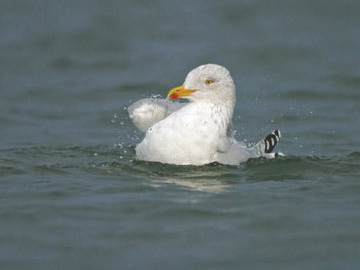
Herring Gull © Steve Round
Herring Gulls were reported in winter from slightly fewer tetrads than Lesser Black-backed Gull (200 against 219) but they were more numerous and gathered into larger flocks. The biggest gatherings were at the north-west corner of the Wirral, with maxima of 8,000 on Hoylake shore and 5,000 off Hilbre, but the Gowy landfill site attracted many, with 5,000 being estimated loafing on nearby fields (SJ47L). There were many solitary birds and small groups, however, and the median count was only ten birds.
The old word of ‘seagull’ probably used to be more appropriate. Bell (1962) wrote that ‘the most significant change since Coward’s time is probably its winter status inland’, and Boyd (1951) noted that Herring Gulls had become much more abundant and widespread, beginning about 1927. The distribution map shows that they occupy more tetrads from SJ57 north-westwards, and obviously fewer in the centre and southwest of the county, than Lesser-black Backed Gulls. Herring Gulls are more likely to be found in human sites than Lesser-black Backed Gulls (12% of records against 8%), especially suburban areas of the Wirral, and on tilled farmland. These gulls are omnivorous. Probably most of them feed at sea, taking fish or invertebrates, but many scavenge on refuse tips and take whatever they can find, even small mammals, from farmland.
The Mersey Estuary was the only site in the county to record a roost count exceeding 1% of the British national total (380,000 Herring Gulls) in the January 1993 WinGS (Wintering Gull Survey) when a total of 5,321 was counted. Only 318 were found during the 2004 repeat survey, though.
The Handbook of Birds of the World regards the systematics of the Herring Gull and its close relatives as ‘one of the most complex challenges in ornithology’. Although excessive prominence is given by some birdwatchers to unusual races, and most of the species’ accounts in the annual Cheshire and Wirral Bird Reports are devoted to them, they are rare. Most of the birds from continental Europe concentrate on the east coast of Britain (Migration Atlas). The vast majority of our wintering Herring Gulls comes from northern Britain.
In memory of Doreen Botwood

